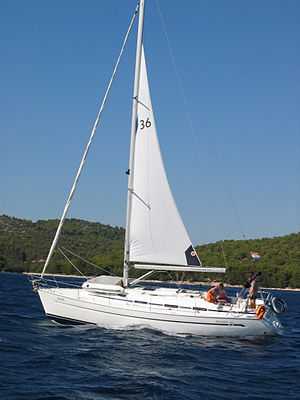Reefing

Reefing is the means of reducing the area of a sail in order to improve a craft's stability and minimize the risk of damage to the sail or boat hardware in a strong wind. Proper skills in and equipment for reefing are crucial to averting the dangers of capsizing or broaching in heavy weather.
Modern sailboats often combine reefing and furling of sails. A boat should be reefed if the wind is likely to cause it to heel beyond 25 degrees.
Conventional reefing

Sails may have built-in alternative attachment points that allow their area to be reduced. In a mainsail, one to four horizontal rows of cringles or lines, called reef points, may be placed above the foot of the sail. Rolling up the foot of the sail and tying these reef points to the foot of the sail forms a new tack and clew, reducing the sail's area. More than one row of reef points increases options for possible sail area.
To reef the sail of a Bermuda rigged sloop:
- The boat should be brought head-to-wind (in irons).
- Lower the jib and main sail. Leaving the jib up allows it to turn the boat away from the wind. Lowering the main just enough to reef runs the risk of having the wind change directions, blowing the main outboard and filling the sail. Set the boom in the boom crutch and pull the sheet tight.
- Lash the tack reef cringle to the boom. Pull the leech reef cringle away from the mast, stretching the sail taut along the boom. Lash the leech cringle to the boom, and then to the end of the boom. Then tie the remaining reefs with sail ties. With lighter gauge sails or reef points reef the sail to itself rather than around the boom to prevent the reefing cringles from being torn out. Secure the sail ties with a reef (square) knot.
- Once the sail is reefed, raise the main, stow the boom crotch, raise the jib, and bear off. If the reefing is done while moored or in sheltered waters, the sail to be reefed need not be lowered entirely. One crewman must pull the reefing line as another crewman lowers the sail.
Roller reefing
Roller reefing rolls or wraps the sail around a wire, foil, or spar to reduce its exposure to the wind. In mainsail furling systems the sail is either wrapped around the boom by a mechanism in the gooseneck or hardware inside the boom winds it around a rotating foil.
Furling systems controlled with lines led to the cockpit allow reefing without crew having to go on deck in heavy weather. Roller reefing also allows more variable sail area than conventional or jiffy reefing. Countering these advantages are the furled sail possibly not having an optimal shape and sail repair or replacement being more difficult.
Jiffy reefing
Jiffy reefing, also called slab or single line reefing, is an alternative to conventional or roller reefing where the sail is folded in sections, or slabs, along the boom. One or two reefing lines reeved through the sail's luff and leach reef cringles create a new tack and clew for the sail by pulling those points tight to the boom. These can be led back to the cockpit to allow crew members to reef without going on deck in heavy weather. Intermediate reef cringles are not used.
The equipment for jiffy reefing is sometimes integrated with Dutchman flaking, a furling technology that flakes (or folds up) the sail on alternate sides of the boom.
See also
References
- ↑ The Annapolis Book of Seamanship by John Rousemaniere
| ||||||||